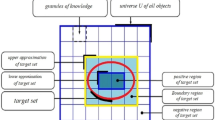Abstract
Conventionally designed questionnaires frequently use the Likert Scale to gauge the feeling of respondents. The dichotomy and the same interval integer are clear-cut. Owing to the fuzziness of human thinking, this approach is inadequate and too simple to rule subject’s way and measure complex human thinking and cognition. Consequently, this investigation integrated the five dimensions of SERVQUAL and adopted a Fuzzy set theory based approach. The five criteria of SERVQUAL were tested for four department stores using Fuzzy set theory to clarify the positioning of service quality in the department store market and propose implementation priorities for different service strategies. This result permits managers to collate the service strategy of the benchmarking department store and its local competitors, and also enables department store decision-makers to consider the weights of the five dimensions when modifying the service strategy. The analytical results can be used to improve strategy development, and to devise superior and more effective management methods.
Similar content being viewed by others
References
Andrea R. (1997). Linking organizational effectiveness, key success factors and measures: an analytical framework. Management Accounting Research 8: 207–219
Asan U., Erhan B.C., Seckin P. (2004). A fuzzy approach to qualitative cross impact analysis. The International Journal of Management Science (Omega)32: 443–458
Chen L.H. Weng M.C. (2002). Using fuzzy approaches to evaluate quality alternative based on quality costs. The International Journal of Quality and Reliability Management 19(2): 122–136
Cronin, J. J. Taylor, S. A. (1992). Measuring service quality: a reexamination and Journal of Marketing 56(July): 55–68.
Cronin, J. J. Taylor, S. A. (1994). SERVPERF Versus SERVQUAL: reconciling and perceptions-minus-expectations measurement of service quality. Journal of Marketing 58(January): 125–131
Dabholkar P.A., Thorpe D.I. Rentz J.O. (1996). A measure of service quality for retail stores: scale development and validation. Journal of the Academy of Marketing Science 24(1): 3–16
Dubois D., Prade H. (1978). Operations on fuzzy number. International Journal of Science 9(6): 13–626
Ham C.L. (2003). Analyzing the value of service quality management: gaining advantages. International Journal of Value-Based Management 16: 131–152
Hsiao S.W. (1998). Fuzzy logic based decision model for product design. International Journal of Ergonomics 21: 103–116
Hwang C.L. Yoon K. (1981). Multiple Attribute Decision Making, Lecture Notes in Economics and Mathematical Systems. Berlin, Springer
Kahraman C., Ufuk C., Ziya U. (2003). Multi-criteria supplier selection using fuzzy AHP. Logistics Information Management 16(6): 382–394
Lin, Shu-Chen, Liang G.-S., Ye K.-D. (2005). A survey investigation of airports as centers: a strategic advantage perspective. International Journal of Managemaet 22(3): 396–414
Michael D.C., Lucie K.O., Wlater L.L. (2001). Patients’ perceptions of service dimensions: an empirical examination of health care in NEW Zealand. Health Marketing Quarterly 19(1): 3–22
Prascevic, Z. Petrovic-Lazarevic, S. (1998). Fuzzy multiple objective decision making in the construction industry. Monash University, Department of Management, working paper, pp. 90–98.
Parasuraman A., Zeithaml V.A., Berry L. (1985). A conceptual model of service quality and its implications for future research. Journal of Marketing 49: 41–50
Parasuraman A., Zeithamal V.A., Berry L. (1988). SERVQUAL: a multiple scale for measuring consumer perceptions of service quality. Journal of Retailing 64: 12–40
Parasuraman, A., Zeithamal, V.A. Berry, L. (1990). An empirical test of the extended gaps model of service quality. Marketing Science Institute Working paper, pp. 90–122.
Parikh D. (2005). Measuring retail service quality: an empirical study in a developing country. South Asian Journal of Management 12(2): 43–57
Saaty T.L. (1980). The Analytic Hierarchy Process, 9th edn. New York, McGraw Hill
Shee D.Y., Tzeng G.-H., Tang T.-I. (2003). AHP, fuzzy measure and fuzzy approaches for the appraisal of information service providers in Taiwan. Journal of Global Information Technology Management 6(1): 8–30
Tsaura S.-H., Changb T.-Y., Yena C.-H. (2002). The evaluation of airline service quality by fuzzy MCDM. Tourism Management 23: 107–115
Ufek C., Ahmet B. (2002). An approach to the evaluation of quality performance of the companies in Turkey. Managerial Auditing Journal 17(1/2): 92–100
Wang Y., Lo H.-P., Hui Y.V. (2003). The antecedents of service quality and product quality and their influences on bank reputation: evidence from the banking industry in China. Managing Service Quality 13(1): 72–83
Wu W.-Y., Hsiao S.-W., Kuo H.-P. (2004). Fuzzy set theory based decision model for determining market position and developing strategy for hospital service quality. Total Quality Management and Business Excellence 15(4): 439–456
Zadeh L.A. (1965). Fuzzy sets. Information and Control 8: 338–353
Zadeh L.A. (1975). The concept of a linguistic variable and its application to reasoning. Information Sciences 8: 199–249
Zeithaml V.A. (1996). The behavioral consequences of service quality. Journal of Marketing 60(2): 31–46
Zhou D., Ma J., Efraim T. (2001). Journal quality assessment: an integrated subjective and objective approach. IEEE Transactions on Engineering Management 48(4): 479–490
Author information
Authors and Affiliations
Corresponding author
Rights and permissions
About this article
Cite this article
Tsai, MT., Wu, HL. & Liang, WK. Fuzzy Decision Making for Market Positioning and Developing Strategy for Improving Service Quality in Department Stores. Qual Quant 42, 303–319 (2008). https://doi.org/10.1007/s11135-006-9047-1
Received:
Accepted:
Published:
Issue Date:
DOI: https://doi.org/10.1007/s11135-006-9047-1




